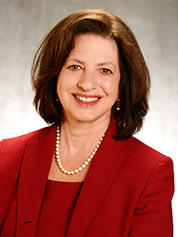 By David Giambusso
By David Giambusso
06/13/2016 09:10 PM EDT
Addressing a common criticism of New York’s Reforming the Energy Vision, Public Service Commission chairwoman Audrey Zibelman said Monday that the state had made significant, tangible progress in its quest to redesign how power is delivered and consumed.
“‘We get a lot of this. [People] say ‘Ok you did this order, but what have you guys really done?'” Zibelman said during remarks for the opening of New York Energy Week, a week of events and discussions that was set up by the company EnerKnol and focuses on the technological and philosophical changes in the energy business. The kickoff was held at National Grid’s Brooklyn headquarters.
“We get that criticism a lot which, quite frankly, we take a lot of insult about,” Zibelman said.
REV is, at its core, a regulatory regime change in New York designed to alter utility business models to incorporate significantly more clean energy into the grid than currently exists. Since it was first rolled out in 2013 and 2014, REV has become something of a catch-all for the Cuomo administration’s numerous initiatives to encourage an increase in renewable energy and energy efficiency.
“When you think about where we were three years ago and where we are in New York, it’s an incredible difference,” Zibelman said.
Last month, the PSC issued its policy directive for utilities to use as a guide when coming to the state with rate filings. Much like government budgets, a utility’s rate case is an expression of its priorities and the direction it wishes to take in the future.
The order was a specific set of criteria on which utilities will be rewarded and punished under the REV model. It encourages third-party companies, such as solar, wind or tech developers to become more integral to the power delivery process. It encourages customer engagement. It rewards efficiency measures. But the key principle behind the order is to encourage utilities to find new revenue streams beyond the traditional expansion of infrastructure, and charging customers for delivery.
“For the first time since the industry developed in the 20s and 30s, we’re starting to take a look at how we use distributed energy resources better,” Zibelman said.
Distributed energy consists of small, generally renewable sources of power that the state hopes will form the backbone of the new grid. To that end, the PSC asked utilities to develop demonstration projects that adhere to the principles of REV.
Earlier Monday, Con Edison rolled out its virtual power plan, one of its demonstration projects that in partnership with two outside vendors, coordinates rooftop solar arrays, energy storage and smart meters to reduce the demand on the grid and dispatch power elsewhere as needed.
Zibelman said demonstration projects underway at Con Ed, National Grid and the state’s other utilities are among the chief accomplishments of the REV process so far.
“In order to get utilities to learn how use these resources and really rethink their business model, we really need experience,” Zibelman said. “We want them to do. We want them to learn … and then tell us based on the experience, where can we take this.”
She said the Cuomo administration’s work in other areas, such as the $5 billion Clean Energy Fund, the New York Green Bank, and a mandate to use 50 percent renewable energy by 2030 are all aiding in the push to redesign the state’s grid.
Aside form the demonstration projects, Zibelman said the state added 37.8 megawatts of energy storage; began the first community solar project north of Albany, ushered in a Community Choice Aggregation program in Westchester where municipalities buy power; tightened regulations for non-utility, independent energy service companies; and embarked on a statewide energy affordability project.
Zibelman said that the most important thing happening was that state regulators are allowing utilities to take chances on new ideas and new technologies in order to achieve a mutual policy end.
“If anything that’s really changing the culture of utilities [it’s] really saying, ‘We get a chance to innovate and we don’t have regulators sitting there as Monday morning quarterbacks saying why did you that?'” she said. “If anything’s going to get us moving, that’s gonna get us moving.”
To view online:
http://www.politico.com/

